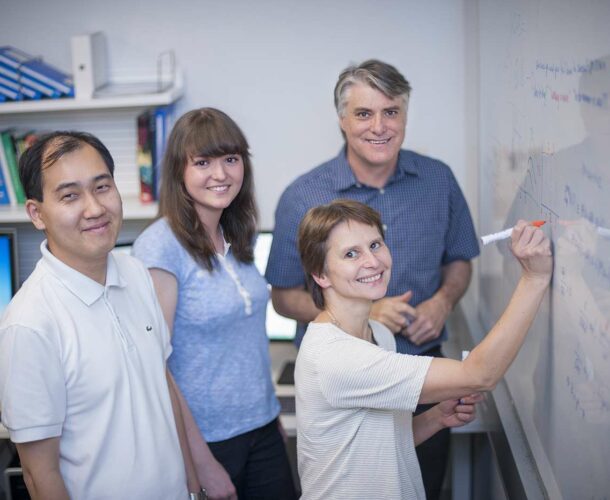In 2014 researchers from the institute define for the first time how the size of the immune response is controlled, using mathematical models to predict how powerfully immune cells respond to infection and disease.
The finding, published in the journal Science, has implications for our understanding of how harmful or beneficial immune responses can be manipulated for better health.
The research team used mathematics and computer modelling to understand how complex signalling impacts the size of the response by key infection-fighting immune cells called T cells. The team included Ms Julia Marchingo, Dr Andrey Kan, Dr Susanne Heinzel and Professor Phil Hodgkin from the Walter and Eliza Hall Institute, and Professor Ken Duffy from the National University of Ireland, Maynooth.
A detective story
“Science at its best is, in the end, like a good detective story,” according to Melbourne-based Nobel laureate and immunologist Peter Doherty. “It offers the chance to ask the questions, search for clues, uncover what is hidden and come to a conclusion or, even better, a solution.”
In this whodunnit Julia Marchingo is the rookie investigator who has – precociously, aged 26 – unearthed some intriguing, possibly vital clues in the labyrinthine mystery that is the immune system.
Marchingo arrived on the scene barely five years ago. Raised in suburban Surrey Hills, with science in her veins on her mother’s side (a pharmacologist) she was just completing her undergraduate degree in biomedical science at the University of Melbourne, not entirely sure of her next step. Something in science, certainly. Enlisting mathematics, ideally. And she was intrigued by immunology, courtesy of exposure to lecturers recognised as leaders in the field.
A serendipitous meeting
She went along to an open day at the Walter and Eliza Hall Institute, hoping that might deliver some inspiration. But nothing quite clicked until she was waylaid on her way out and providence, in the form of Phil Hodgkin, stepped in.
“He asked what I was interested in. I said something vague like ‘how the immune response is regulated’, and he exclaimed ‘that’s exactly what I work on’. He showed me a movie of a B cell where all the progeny cells arising from the one clone did the exact same number of divisions, and then they all stopped at the same time. How do they all know to stop? I thought it was the coolest thing ever.”
Hot on the T-cell trail
An honors year extended into a PhD, which she has just delivered, largely preoccupied with answering some of the questions that ran through her mind the first time she saw those cells dividing and dying according to some orchestrated rhythm. What’s controlling and regulating those changes? How might those changes be anticipated and manipulated to deliver better medicine?
Marchingo joined a team enlisting both biological data and mathematical models to understand how different external signals impact on the proliferation of T cells, the white blood cells that are the soldiers of the immune system, hunting down germs and cancerous cells, attacking them directly or calling in reinforcements for an immune response.
“T cells receive many signals, each of which programs in a certain number of divisions,” Marchingo explains. “We found that if you know the number of divisions each individual signal programs, you can predict the total number of divisions the cells will do when the signals are combined, and therefore the size of the immune response.”
Armed with this information, scientists can, for the first time, predict the size of an immune response to – say – a flu virus, based on the sum of the signals received by the flu-responsive T cells.
A powerful cancer tool
This knowledge promises to be very powerful in tailoring cancer therapeutics and vaccines, providing insight into how the various factors that boost immune response can work together, and what combinations might dial up the optimal immune response. It’s all just a question of doing the sums.
The work was published in the journal Science in late 2014 and gained international headlines. Marchingo was the first-listed author, even before her PhD was delivered.
What comes next for (soon-to-be) Dr Marchingo is not yet certain. She’ll likely do postdoctoral studies overseas. She’s inclined to keep working in T cells, in immunology, her Walter and Eliza Hall Institute experience having been so powerfully defining professionally and personally.
“The first day I started honors at the institute, Phil (Hodgkin) came to pick me up at security. Walking in he said ‘you should meet this man – this is Jacques Miller. He discovered the T cell’. He still hangs around the laboratory. We’re good friends. He wanders in and asks me what I’m working on.” Working with such legends, she says, “we’re just spoiled, so lucky.”






